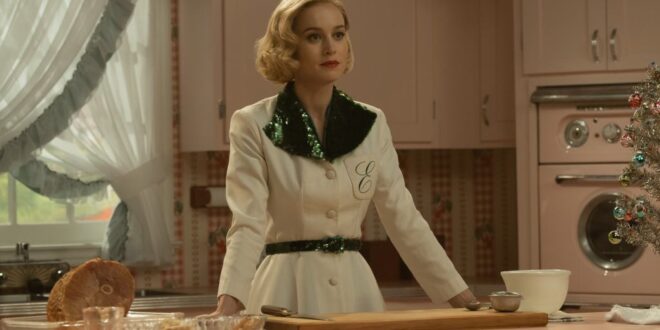In the decade since her breakout in “Short Term 12” and the seven years since she won an Oscar for “Room,” Brie Larson has become a kind of cautionary tale for how little Hollywood has to offer its rising stars. After achieving the industry’s highest honor, Larson has largely cycled between blockbuster franchises (“Captain Marvel,” “Fast X”) and car commercials (Audi, Nissan). She’s been a well-compensated gun for hire, slotting into various corporate entities after a pair of intimate indie dramas put her on the map. Nor has Larson substantially filled the downtime between these money jobs with “one for me” projects; “Unicorn Store,” her 2019 directorial debut, was a candy-colored ode to juvenilia at odds with the adult fare one would hope a performer of Larson’s stature would spend cultural and literal capital on. Perhaps she viewed advocacy as an advisory board member of Time’s Up as a better use of those resources, though the #MeToo-adjacent organization has since shut down operations.
The Apple TV+ limited series “Lessons in Chemistry” is therefore the first Larson offering in some time to lean on and showcase her skills as an actor. Granted, the show is also a piece of reworked intellectual property. Adapted by creator Lee Eisenberg from the novel by Bonnie Garmus, with Larson executive producing, “Lessons in Chemistry” is only the latest graduate of the middlebrow-bestseller-to-prestige-television pipeline. (Others include “Daisy Jones & the Six,” “Nine Perfect Strangers” and, soon, Hulu’s “Black Cake.”) But while scientist Elizabeth Zott is Garmus’ creation, Larson gets to make more of a mark on the character than she ever did on Carol Danvers or the “Fast & Furious” family.
At the story’s outset in the early 1950s, Elizabeth is a lab tech at the fictional Hastings chemical institute in Los Angeles, though a flash-forward tells us she won’t always have her credentials diminished by condescending male supervisors. Eventually and improbably, Elizabeth will become the host of a hit cooking show called “Supper at Six,” channeling her scientific know-how through its most accessible — and acceptably gendered — application like a mix of Julia Child and Alton Brown. Men won’t listen to a young woman’s theories on abiogenesis, but they will let her explain to an audience of housewives why baking powder creates crispy chicken skin.
To travel between these two points, “Lessons in Chemistry” speeds through a decade’s worth of love, loss, single parenthood, drastic career change and, somehow, the history of urban development in the Southland. In squeezing all of Elizabeth’s life into eight hourlong episodes, “Lessons in Chemistry” sometimes shows the strain of adaptation. Devices transplanted directly from the book, like an episode narrated by Elizabeth’s dog, are an awkward fit for the screen; new additions, like a subplot about freeway construction destroying a historically Black neighborhood driven by Elizabeth’s neighbor Harriet (Aja Naomi King), are too obvious an attempt to expand the story. The shameful legacy of so-called urban renewal is a worthy subject for its own series, but when shoehorned into this one, the storyline feels crafted as a complement to Elizabeth’s journey rather than an organic extension — no chemistry pun intended.
Other weak points are more inherent to the enterprise. Midcentury misogyny was not subtle, and neither is Elizabeth’s experience of it. “Lessons in Chemistry” is yet another instance of the trauma plot, the causal link between a protagonist’s most harrowing experiences and future trajectory rightly critiqued for overuse by The New Yorker critic Parul Sehgal. By series’ end, Elizabeth has been saddled with several such events, including a sexual assault and multiple sudden deaths of loved ones. When her conditions start to improve, the show takes on elements of wish fulfillment. Elizabeth’s description of cooking as a source of personal agency — “Cooking is chemistry, and chemistry is life. Your ability to change everything, including yourself, starts here” — is nicely put. Her speech to a housewife she urges to stop doubting herself and become a doctor is the stuff of inspirational posters on a classroom wall.
But the strengths of “Lessons in Chemistry” are qualities often missing from both modern entertainment as a whole and, more specifically, Larson’s IMDb page. It’s no longer remarkable for an Apple series to boast luxurious credits, or lavish production and costume design; even a swimsuit Elizabeth wears in a relatively minor scene is impeccably styled and fit. It is a pleasant surprise to watch Larson craft Elizabeth into a woman more idiosyncratic than a wronged and righteous underdog. Technically minded and socially awkward, Elizabeth has a genuinely difficult time with all kinds of social interaction, not just those with men in power. She becomes the kind of mother who encourages her infant daughter to breastfeed by imploring the baby to “succumb to primitive instinct.”
Larson’s work here is distinctive and committed without being self-consciously quirky, and a much better use of her oddball, theater-kid energy than when she’s playing a cool, quippy superhero. (Peruse her YouTube channel or Instagram dispatches about dance and see what I mean.) And when paired with Lewis Pullman as Elizabeth’s scientific soul mate Calvin Evans, the result is a romance affecting enough to power the show and transcend the inevitable wordplay about chemists having chemistry. As “Normal People” proved a few years ago, one undeniable edge TV has over the page is the ability to show bodies together in physical space, and therefore an additional dimension of the relationship between them. Larson and Pullman bring a meeting of the minds into the material world. Their scenes of two kindred spirits resonating on a particular, personal frequency make you want to see more of them both — or in Larson’s case, more of this side of her.
The first two episodes of “Lessons in Chemistry” premiere on Apple TV+ on Oct. 13, with remaining episodes airing weekly on Fridays.
